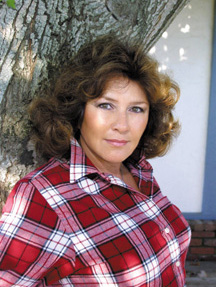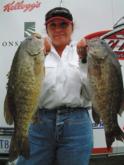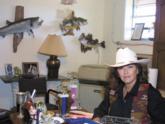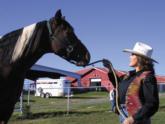Crain’s aim

After achieving one of the highest Pro Division finishes in history for a woman on the FLW Tour, Shirley Crain has set her sights on a tour win.
They say it takes 30 days to kick a bad habit.
If that’s indeed the case, then Arkansas bass pro Shirley Crain has plenty of time to clean up her act before the Wal-Mart FLW Tour brings its traveling road show to Beaver Lake next April for the Wal-Mart Open.
Crain is a fierce competitor who’s prone to gamble when there’s big bucks on the line, especially when she’s casting for cash on a lake she knows like the back of her hand.
A successful businesswoman, Crain has cut some of her best deals over the years on a roll of the dice. But up until now she hasn’t gotten the right combination to roll a lucky seven on the prestigious bass fishing tour.
Twice Crain has gambled on getting the big bite at her home lake. But as her vitals reflect, they were big bites that never came.
Her first FLW Tour event at the popular Ozark fishery in 2000, the $1 million Wal-Mart Open, ended in a disappointing 163rd-place finish. In two days she brought only two fish to the scales weighing a meager 4 pounds, 14 ounces.
Crain’s 2001 performance on Beaver Lake proved to be even more frustrating than the first. The Ranger pro ended up in 168th place last spring with a two-day weight of 3 pounds, 5 ounces.
This year Crain has pledged to do something different when the FLW Tour comes to town. And the plan won’t involve making risky decisions or banking on finicky offshore bass at a time of year when they’re apt to move from one day to the next.
Rather than following her instinctive urge to go after the heavyweight pre-spawners she feels sure will be hanging around deep, mainlake structure – the same game plan that has jinxed her the last two years – Crain says she’s going to fish smarter and take a more conservative approach.
“The last two years at Beaver I’ve gone strictly for the big fish, and it has really cost me,” Crain says. “Both years I found big fish before the tournament, but then they went to the beds. Rather than going after an easy limit early like everyone else, I stayed with the big fish the whole time and tried to make something happen. Unfortunately, it never did.”
Crain was justifiably shaken by her most recent finish in the $1 million Wal-Mart Open on Beaver Lake, but she didn’t let it get her down. She’s way too salty for that.
A veteran bass angler with nearly two decades of tournament fishing experience under her belt, Crain merely shifted her focus to Lake St. Clair in Detroit where she banked $10,000 after posting the banner performance of her fishing career in the $1 million Forrest Wood Open.
 Competing as the only woman angler in the Pro Division, Crain landed back-to-back limits during the first two days of competition and fished her way to a 16th-place finish in the overall standings – the best-ever finish for a female pro in Wal-Mart FLW Tour history.
Competing as the only woman angler in the Pro Division, Crain landed back-to-back limits during the first two days of competition and fished her way to a 16th-place finish in the overall standings – the best-ever finish for a female pro in Wal-Mart FLW Tour history.
Crain’s accumulative weight for two days totaled 28 pounds, 5 ounces, slightly more than a pound away from the top-10 cut.
“I lost three fish during the tournament that would have let me break into the top 10, and that was very exciting for me,” Crain said. “Just knowing that I was able to get that close and that I had the skills to do it was especially satisfying.
“I’m hopeful that I’ve found the key to solve all the problems I was having the first two years,” she added. “I’ve really been playing a mental game with myself thus far, but I’ve never been more confident than I am right now. I am going to win one of these tournaments.”
Crain’s confidence doesn’t pivot on the hinge of a single fishing performance.
She’s got deep-seated competitive roots dating all the way back to the early days of fishing organizations like Lady Bass and Bass-N-Gal, both of which saw her qualify for their year-end championships on several occasions.
She also was a regular on the Women’s Bass Fishing Association (WBFA) circuit until last year. That’s when she decided to focus her fishing future on a league where the stakes, paybacks and opportunities for lucrative sponsorship dollars are considerably higher.
Crain won’t tell how old she is at any price, but she’s been bass fishing competitively longer than many of the nation’s best-known pros.
She fished her first tournament as a non-boater in 1984. The site was Kentucky/Barkley Lake, and she drew out with Vojah Reed, a true ambassador in the world of women’s professional bass fishing.
“I’ll never forget that day,” Crain said. “We ran 70 miles one way. We both caught fish, but I was the only one who caught any keepers. Even so, Vojah was determined to get me back to weigh-in on time, and that meant navigating some pretty rough water. I remember being terribly impressed with her ability to handle the boat around all the barge traffic. I don’t think anyone else could have done it better.”
Pro bassin’: Then and now
Seventeen years have gone by since Crain anted up for her first tournament. But the bass-fishing industry hasn’t stood still.
If anything, it’s raced forward in an effort to keep pace with the insatiable appetites of the millions of performance-hungry anglers who cast for cash on the professional and amateur levels.
Boats are bigger, faster and sleeker than ever. Tackle is lighter, stronger and smoother. Electronics are more refined, precise and high-tech.
Moreover, professional tournament fishing is no longer thought of as a good ol’ boys club comprised of beer-drinking buddies and weekend warriors.
It’s a business – a serious business – where those with the right touch are earning comfortable livings from tournament winnings and monthly retainers from sponsors willing to pay them to use, promote and endorse their products.
Twenty-five years ago a major tournament win may have been worth $10,000-$15,000. Today, full-time pros are competing for 20 times that amount, often multiple times during the course of a year.
And they aren’t all men, either.
 But Crain would rather not get too deep into that discussion. In her opinion, the topic of women’s acceptance into the world of high-stakes bassin’ is an old hat that needs to be buried.
But Crain would rather not get too deep into that discussion. In her opinion, the topic of women’s acceptance into the world of high-stakes bassin’ is an old hat that needs to be buried.
“It is no longer an issue,” she says. “Women have been accepted by the different organizations as well as the male fishermen because we’ve proven we can fish without being a handicap. It’s time to move on.”
In retrospect, Crain believes there are more important issues that should be addressed as female anglers continue to press forward with their levelwinds in hand. Perhaps the most critical of all is linked to a little term called “self respect.”
Don’t sell yourself short
Crain once took a job at a television station as promotions manager. She’d been working there for a spell before she learned she’d hired on for about one-third the salary paid to the man she replaced.
A rare occurance? Certainly not.
According to Crain, women historically have been willing to take less money to do the same work as men – a stereotype she says many female anglers continue to tote despite their acceptance into the professional bass-fishing arenas.
“I know a lot of talented female anglers who today are willing to wear sponsor shirts, caps and patches for a little bit of nothing,” Crain says. “They travel here and there working boat shows and doing other promotions. Yet, when you figure their time, they might be making about $1 per hour.
“That’s fine if you do it because you love it,” she adds. “But in reality it’s selling women short because it is preventing the women who are trying to make a living in this business from doing so.
“The girls need to respect themselves. If they accept a cap, shirt or patch from a sponsor, they should expect to be compensated for wearing it. Those who do it for a little bit of nothing aren’t helping themselves or anyone else.”
The road ahead
Crain, who is currently sponsored by industry giants Ranger, Minn Kota and Mercury, says her tournament schedule is about as busy as it’s going to get. She intends to make all the Wal-Mart FLW Tour events this season, but she’s not going to beat herself up in the process.
“I’m a very competitive person and I’d love to fish every tournament that comes along, but it just wouldn’t be worth what I’d have to give up,” she says. “Someone once told me the key to happiness is recognizing when you’re happy. At this point in my life I can honestly say I’m happy. And I’m very grateful for that.”
While competitive fishing plays a key role in her life, Crain isn’t so obsessed with the sport that she eats, sleeps and breathes it. There are plenty of other things to hold her interest when she’s not on the water.
The Arkansas pro and her husband, H.C. “Dude” Crain, have entrepreneured several small businesses. Plus, the couple owns a 175-acre ranch outside Van Buren where Shirley rides shotgun over 130 Arabian and Paint horses and oversees the springtime breeding and foaling operation.
In addition to her outside interest in horses, Crain enjoys writing children’s fiction and painting. She’s also a licensed pilot who has flown solo up to 1,500 miles one way in a single-engine aircraft.
“Shirley Crain is a pretty diverse individual who likes to do a wide variety of things,” she said. “But she’s not through developing just yet. I hope to continue doing that until the day I die.”
